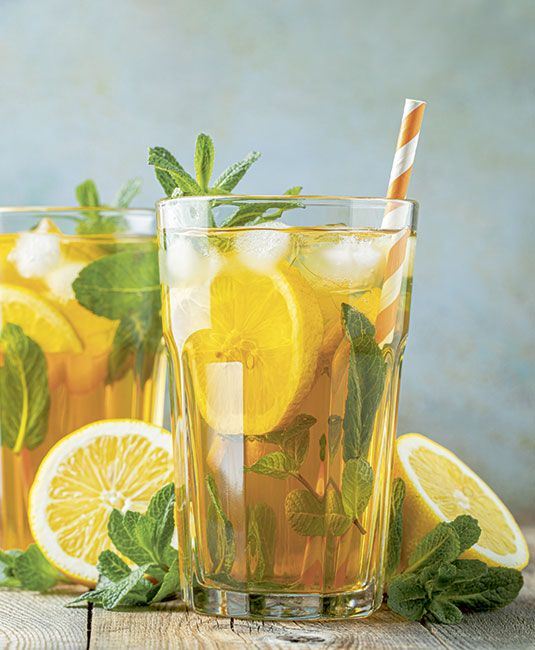Iced teas, the healthy choice for summer
Refreshing and thirst-quenching, iced tea, when prepared simply as it is with good-quality leaves, is a flavorsome and healthy drink for summer – good for your body and the planet!
The heat of summer is here and with it the need for refreshing drinks. It’s better to drink healthy home-brewed alternatives rather than ready-made sweetened beverages. Interestingly, the craze for iced tea doesn’t come from hot countries, where people are used to drinking hot tea, but from the United States.
Did you say iced tea?
The British were the first to add ice cubes to their cuppa. At the end of the eighteenth century, English and American cookbooks record the common practice of serving tea chilled, sometimes combined with spirits. Black tea, imported at a lower cost, quickly supplanted green tea.
Richard Blechynden is credited with making iced tea popular, at the 1904 World’s Fair in St Louis, Missouri. As the Commissioner of Indian Tea and Director of the East Indies pavillion, he served visitors hot tea, but the heat-weary crowd wasn’t keen on it. So he decided to offer iced tea and the thirsty visitors lapped up the refreshing drink. Iced tea became hugely popular, appearing on hotel menus and sold in train stations.
It was also produced for mass consumption – made from highly sweetened powdered tea – and soon iced tea was being consumed almost everywhere in the world. In Japan, the teas are very well suited for brewing at room temperature, and are enjoyed both hot and cold. In countries such as Thailand, iced black tea is traditionally made with spices and milk.
In South America, mate is drunk very chilled in hot weather, sometimes with lemon or mint. In Europe, Switzerland is said to be the largest consumer of iced teas. 100g of Palais des Thés loose-leaf tea will make 6.25 litres of iced tea, the equivalent of a pack of iced tea bottles sold in supermarkets.
Richard Blechynden is credited with making iced tea popular, at the 1904 World’s Fair in St Louis, Missouri. As the Commissioner of Indian Tea and Director of the East Indies pavillion, he served visitors hot tea, but the heat-weary crowd wasn’t keen on it. So he decided to offer iced tea and the thirsty visitors lapped up the refreshing drink. Iced tea became hugely popular, appearing on hotel menus and sold in train stations.
It was also produced for mass consumption – made from highly sweetened powdered tea – and soon iced tea was being consumed almost everywhere in the world. In Japan, the teas are very well suited for brewing at room temperature, and are enjoyed both hot and cold. In countries such as Thailand, iced black tea is traditionally made with spices and milk.
In South America, mate is drunk very chilled in hot weather, sometimes with lemon or mint. In Europe, Switzerland is said to be the largest consumer of iced teas. 100g of Palais des Thés loose-leaf tea will make 6.25 litres of iced tea, the equivalent of a pack of iced tea bottles sold in supermarkets.
100g
of Palais des Thés loose-leaf tea will make
6.25 litres
of iced tea, the equivalent of a pack of iced tea bottles sold in supermarkets.
CAFFEINE-FREE
Iced tea does contain caffeine but at a lower concentration than hot tea, as the caffeine molecule diffuses more slowly at room temperature or colder. Try experimenting with premium teas: their high proportion of buds will add complexity but are also a great source of caffeine. By infusing teas at room temperature or colder, you can enjoy a first-flush Darjeeling or an Ichibancha at the end of the day without fear of disrupting your sleep. In general, if you are sensitive to caffeine, go for teas like Hojicha and Kukicha, or Oolong which is naturally low in caffeine.

Good for the planet...
Among beverages, tea has the smallest carbon footprint (19g of CO2 per cup on average). In this positive environmental context, it’s the preparation of tea, particularly boiling the water in a kettle, which emits the most CO2. When you’re steeping loose leaves at room temperature and not buying more plastic bottles, it makes iced tea the world’s best drink in terms of its environmental impact.
... and for the body?
Overall, iced teas brewed at room temperature offer the same health benefits as hot teas, with a slight advantage in terms of vitamin intake (the vitamin C in the leaves is destroyed by heat). Water that is too hot also destroys some compounds including amino acids, which are present in large quantities in green tea. While heat helps most of the natural substances in the leaves to dissolve, it also destroys or changes some of them (the hotter the water, the more these compounds migrate into the aqueous phase).